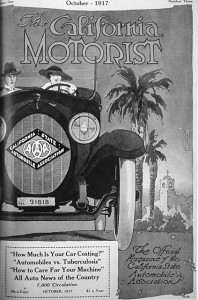The Spirit Of The Road : One Hundreds Years of the California State Automobile Association by Tom Turner & John Sparks. Coffee table book. Great photos.


——————–
A Love Affair with the Automobile
by June Morrall
Seeking to promote the exhilaration that comes with motoring, automobile club enthusiasts drove a fleet of horseless carriages from San Francisco to the San Mateo County countryside in 1902.
After a hearty luncheon, the caravan of more than two dozen strange-looking vehicles putt-putted along scenic Crystal Springs Road, leaving spectators aghast. The memories of the magical trip were captured forever on film as they paused for photographs in the beautiful setting.
It was a historic moment. The pioneering motorists demonstrated that they could move about the countryside at their own pace with no need to feed any horses or check the Southern Pacific railroad’s schedule.
The automobile rally at Crystal Springs was a smashing success, but it was 1902, and the horse was still king. The many critics of the motorized vehicle denounced them as highly unreliable, noisy and smelly “Whizz-wagons” with no future, just a passing fad.
One hundred years ago the owner of a new motor car was considered an adventurous type, but he still required a book of instructions to operate the vehicle.
“It won’t start,” was a common complaint.
Automobiles had to be hand-started, a frustrating process that involved checking the gears, the brakes, the switch-plug, and making adjustments to the spark and throttle. While three to five cranks were usually needed to start the car, the risk of a backfiring engine could send the crank handle spinning around counter-clockwise, bruising or breaking the automobilist’s bones.
There were other lessons quickly learned, or you suffered the consequences.
Motorists had to remember not to accidentally fill the gasoline tank with water or to strike a match when inspecting the carburetor. When driving after dark, the vehicle had to be stopped to turn on the headlamp, another procedure that could easily go haywire.
Mud on the primitive roads was a constant problem, as were blowouts of the weak, fabric tires then in use. Automobile breakdowns plagued almost every sojourn, and stranded motorists had little assurance that help was on the way. They could only hope that a fellow automobilist would happen by and rescue them.
The automobile was gaining popularity, and the problems screamed out for solutions. It was not surprising that the trials and tribulations of motoring motivated the rugged early pioneers to seek out one another.
In March 1900, 25 motorists met at the Cliff House in San Francisco. The historic outcome of the meeting was that 11 of those present formed the Auto Club of San Francisco, which later evolved into the California State Automobile Club (CSAA).
The original thrust of the San Francisco meeting was the establishment of a social club, but it soon became apparent that there were more important issues involving the safety and freedom of automobile owners. Most of California remained uncharted territory, with few roads suitable for car travel and no road maps. The rare posted signs often indicated the wrong directions.
The rights of motorists were rarely recognized. Automobilists could not transport their vehicles on ferries crossing San Francisco Bay until they had drained their tanks of gasoline. Local officials arbitrarily closed regions of the state to motor vehicle traffic. Hidden in roadside shrubbery, policemen were known to toss a dummy directly into the path of an oncoming vehicle to see if the driver could brake quickly. If the unsuspecting motorist rolled over the dummy, the driver was in big trouble.
The myriad problems facing the motorist meant that a more ambitious organization was needed. The Automobile Club of California (ACC) was launched in 1901 with the expanded goal of increasing the pleasure and safety of owning and operating a motor vehicle. This required favorable legislation, better roads, improved cars, and increased aid and assistance to motor car owners.
The recreational image of motoring remained a high priority, and the club’s first project was to open Golden Gate Park to automobile traffic. To the south, they sponsored rallies into San Mateo County, and their efforts also brought automobile traffic to Palm Drive on the Stanford campus.
All the while, a drive into the countryside remained hazardous on the rutted, muddy trails which took a heavy toll on the cars. Club members were expected to stop and help stranded motoristss with the loan of a spare tire or replacement part.
Members carried all sorts of paraphernalia including picks and shovels to make bad stretches of roadway navigable.
In 1904 the club endorsed a move to turn El Camino Real into a modern thoroughfare, appropriating $6,000 from the club’s treasury to help finance the construction. Eight years later, El Camino Real was designated the first offical state highway in San Mateo County.
The ACC was instrumental in the adoption of a motorist’s bill of rights: Roads that had been arbitrarily closed were re-opened; unreasonable restrictive speed and operational requirements throughout California were ended. Most significant was the publication of the first road map of the Bay Area, issued with the club’s endorsement.
But it took a natural disaster for the automobile to finally silence its detractors. The turning point came during the 1906 earthquaked when fire department officials gave the motor car their wholehearted endorsement, citing the automobile’s reliability for helping save lives and property during San Francisco’s cataclysm.
Auto clubs were springing up all over the state, and it became evident that one central organization was necessary to advance motoring. In 1907 the California State Automobile Association (CSAA) was incorporated, with Leon Percival Lowe serving as its first president. No longer would the club emphasize the social side of automobile life. The CSAA pioneered the placing of road signs in the Bay Area, and L.P. Lowe himself supervised the erection of the first sign in San Francisco, posting accurate directions to San Mateo, Redwood City and Palo Alto. Additional directions were posted pointing motorists from San Mateo to Santa Cruz via Half Moon Bay, Pescadero and Davenport.
By 1910 the automobile had become an integral part of American life. Until then L.P. Lowe had been CSAA’s sole governor but now it needed more breadth in its leadership, and a board of directors, from all walks of life, was chosen.
One of the board’s early actionsw was to divide California into two service areas, with CSAA taking the north and central portions of the state and the long-established Automobile Club of Southern California assuming resp0nsibility for the southern part.
The next decade was dedicated to building a strong membership base while supporting major highway bond measures. By 1912 the association counted nearly 2,000 members. Simultaneously, the electric starter, a dramatic technological breaththrough, became widely available in many new cars.
That significant innovation, combined with the network of a national highway system, encouraged new drivers to take to the road confidentally, visiting such scenic wonders as Yosemite Park, which CSAA helped open to auto travel.
CSAA viewed itself as a service organization, opening a Touring Bureau for motorists seeking information on travel conditions. In 1917 California Motorist debuted, a magazine with auto news, maps, touring features and maintenance tips. The publication was later renamed Motorland, and today it is called Via.
When CSAA inauguerated Emergency Road Service in the early 1920s, motorists stranded with the all-too-common flat tire no longer had to rely on Good Samaritans.
After WWII, CSAA expanded beyond automobile tours, offering travel packages by plane and ship throughout the world.
Lou Frank of South San Francisco worked in the new CSAA travel department after it opened in 1945. Frank recalled that world travel was booming. He personally had escorted several tours on the luxury liner Lurline bound for the Hawaiian Islands, soon a tourist favorite. Mr. Frank wistfully remembered: “The Royal Hawaii was the ‘pink palace,’ and there were only two or three other hotels right there on the beach. We also used to book tours on the “Queen Mary,” the “Normandy,” and other big-name ships that crossed the Atlantic.”
But the airplane came and “forever” changed the nature of travel.
While the nonprofit CSAA offers a full menu of servies to its paying members, the “Emergency Road Service” remains the organization’s most visible and comforting symbol to the driver in distress.
In 2000, when this article was written, the California State Automobile Association celebrated its 100th anniversary, proudly paralleling its history with California’s love affair with the automobile.
